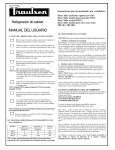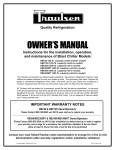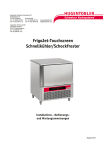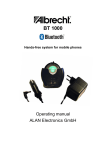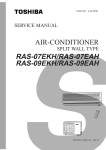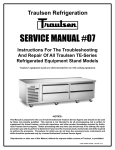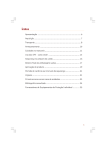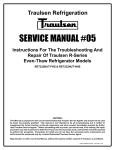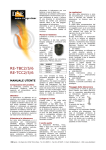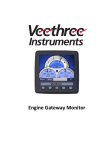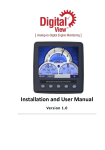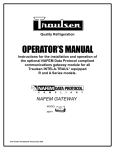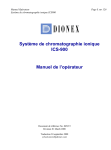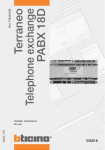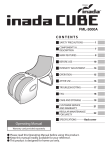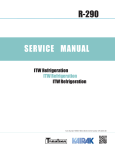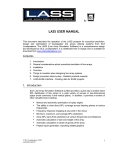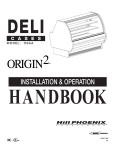Download SERVICE MANUAL #07
Transcript
Traulsen Refrigeration SERVICE MANUAL #07 Instructions For The Installation, Troubleshooting And Repair Of Traulsen epicon® Equipped Blast Chiller Models Undercounter Model TBC5 Reach-In Model TBC13 Roll-In/Roll-Thru Models TBC1H, TBC1HR, TBC2H & TBC2HR -NOTICE- This Manual is prepared for the use of trained Authorized Traulsen Service Agents and should not be used by those not properly qualified. This manual is not intended to be all encompassing, but is written to supplement the formal training, on-the-job experience and other product knowledge acquired by Authorized Traulsen Service Agents. Before proceeding with any work, you should read, in its entirety, the repair procedure you wish to perform to determine if you have the necessary tools, instruments and skills required to perform the procedure. Procedures for which you do not have the necessary tools, instruments and skills should be performed only by a trained Authorized Traulsen Service Agent. Reproduction or other use of this Manual, without the express written consent of Traulsen, is prohibited. FORM NUMBER TR99999 - REV. 8/13 I. TABLE OF CONTENTS I. TABLE OF CONTENTS 1 VIII. SERVICE PROCEDURES a-Temperature Sensors b-Expansion Valve 2 c-Door Perimeter Heaters 2 d-Compressor 2 e-Condenser Fan Assembly 2 f-Condenser Coil 2 g-Pressure Control 2 h-Evaporator Coil 2 i-Filter/Drier j-Evaporator Blower DATA k-Checking For Leaks 3 l-Evacuating The System 3 m-Charging The System 3 n-System Clean-Up o-Replacing The Door Gasket II. GENERAL INFORMATION a-Introduction b-Operation c-Cleaning d-Applicable Models e-Wiring Diagrams f-Tool Requirements g-The Serial Tag III. SPECIFICATIONS/OPERATING a-Product Specifications b-Operating Data c-Refrigeration System Installation IV. SERVICING THE EPICON CONTROL 9 9-10 10 10-11 11 11 11 11 12 12 13 13 14 14 15 IX. WIRING DIAGRAMS - TBC5 16 X. WIRING DIAGRAMS - TBC13 17 XI. WIRING DIAGRAMS - TBC1H MODELS 18 V. CONTROL ARCHITECTURE XII. TROUBLESHOOTING 19-20 XIII. TBC5 REPLACEMENT PARTS LIST 21 XIV. TBC13 REPLACEMENT PARTS LIST 22 XV. TBC1H REPLACEMENT PARTS LIST 23 a-Overview b-The Toolbox 4 4 c-Setting The Clock d-Service Menu e-Service Menu Features 4 4 5 a-Controller Board 6 VI. COMPONENT FUNCTION 7 VII. SEQUENCE OF OPERATION a-Refrigeration System b-Refrigeration System (BC compressor on TBC1H only) c- IDLE Mode d- Hold Mode e-By Time Chill/Freeze Mode f-By Temp Chill/Freeze Mode g-By Product Chill/Freeze Mode h-Defrost Mode` 8 8 8 8 8 9 9 9 Visit the Resource Center @ www.traulsen.com to review the Operator’s Video for this product. -1- II. GENERAL INFORMATION II. f - TOOL REQUIREMENTS (cont’d): II. a - INTRODUCTION: Blast Chillers are food processing refrigerators designed for rapid chilling of product from 140 F to 40 F in approximately 90 minutes, for reheating and/or serving at a later time. These models aid in preserving food quality, texture and nutritional value, in addition to enhancing food safety. All of the information, illustrations and specifications contained within this manual are based on the latest product information available at the time of printing. II. g - THE SERIAL TAG: The serial tag is a permanently affixed sticker on which is recorded vital electrical and refrigeration data about your Traulsen product, as well as the model and serial number. This tag is located inside all blast chiller models. An example is shown below. II. b - OPERATION: Refer to the instructions contained in the Owner’s Manual, form number TR35938, for specific operating instructions. II. c - CLEANING: Detailed cleaning instructions are included with each unit, however, special care MUST be given to the condenser coil(s). These must be cleaned WEEKLY. This surface must be kept free of dirt and grease for proper system operation. This can be done with a vacuum cleaner using a brush attachment, or a stiff brush or wisk broom. Care must be taken not to damage the condenser coil fins. For more information please refer to section V. a, V. e, and V. f of the Blast Chill Owner’s Manual. FORT WORTH, TX. SERIAL VOLTS MODEL Hz PH TOTAL CURRENT AMPS MINIMUM CIRCUIT AMPS MAXIMUM OVERCURRENT PROTECTION LIGHTS WATTS HEATERS AMPS AMPS REFRIGERANT DESIGN PRESSURE TYPE HIGH OZ LOW REFRIGERANT DESIGN PRESSURE TYPE HIGH OZ LOW 370-60294-00 REV (A) II. d - APPLICABLE MODELS: This manual applies to the following Traulsen models: • Refrigeration Reclaiming Equipment • Acetylene Torch • Nitrogen Bottle With Gauges • Refrigeration Gauge Manifold •Dial-a-Charge • Valve Core Removal Kit • Vacuum Pump TBC5 Undercounter Blast Chiller TBC13 Reach-In Blast Chiller TBC1H & TBC2H Roll-In Blast Chillers TBC1HR & TBC2HR Roll-Thru Blast Chillers PLEASE NOTE: This manual refers to the above models built after June 2012, equipped with the epicon® control. For information regarding models built prior to that date please contact the factory. READING THE SERIAL TAG • Serial = The permanent ID# of your Traulsen • Model = The model # of your Traulsen • Volts = Voltage • Hz = Cycle • PH = Phase • Total Current = Maximum amp draw • Minimum Circuit = Minimum circuit required • Lights = Light wattage • Heaters = Heater amperage • Refrigerant = Refrigerant type used • Design Pressure = High & low side operating pressures and refrigerant charge • Agency Labels = Designates agency listings II. e - WIRING DIAGRAMS: Refer to the wiring diagrams on pages 16 thru 18 for any service work performed on the unit. Should you require another copy, please contact Traulsen Service at (800) 825-8220, and provide the model and serial number of the unit involved. II. f - TOOL REQUIREMENTS: For most jobs a standard set of hand tools, a VOM with AC current tester, electrically conductive field service grounding kit, along with a temperature tester or thermometer are adequate. However in some cases the following additional tools may be required as well: -2- III. SPECIFICATIONS/OPERATING DATA/INSTALLATION III. a - PRODUCT SPECIFICATIONS: DIMENSIONS TBC5 Length - Overall in. 54 Depth - Overall in. 34-7/16 Height - Overall in. 34 Capacity 12 x 20 Pans 10 Capacity 18 x 26 Pans 5 Capacity Product Weight 100 lbs. TBC13TBC1HTBC1HR TBC2HTBC2HR 41 48-1/2 48-1/2 48-1/2 48-1/2 34-1/2 37-5/8 41-1/4 71-5/6 75-1/4 74 90-3/8 90-3/8 90-3/8 90-3/8 26 1 Rack 1 Rack 2 Racks 2 Racks 13 1 Rack 1 Rack 2 Racks 2 Racks 200 lbs. 300 lbs. 300 lbs. 600 lbs. 600 lbs. III. b - OPERATING DATA: DATA TBC5 TBC13TBC1HTBC1HR TBC2HTBC2HR Single or Dual System Single Dual Dual Dual Dual Dual Remote Chill Compressor n/a No Yes Yes Yes(2) Yes(2) H.P.1 1 1/2 1/2 1/2 1/2(2) 1/2(2) BTU/HR1 4300 2820 2820 2820 2820(2) 2820(2) H.P.2 n/a 1-1/4 4 4 4(2) 4(2) BTU/HR2 n/a 5710 18,700 18,700 18,700(2) 18,700(2) Refrigerant Type R-404A R-404A R-404A R-404A R-404A R-404A Refrigerant Charge oz. 29 31 25 25 25(2) 25(2) Refrigerant Charge2 n/a 45 See Note3 See Note3 See Note3 See Note3 Condenser RLA1 11.7 5.1 10.5 10.5 10.5(2) 10.5(2) Condenser RLA2 n/a 9.3 See Note3 See Note3 See Note3 See Note3 Unit Voltage 115 208/115 115 115 115(2) 115(2) Phase 1111 11 Hz 60606060 6060 Full Load Amps 13.3 13.4 14.9 14.9 14.9(2) 14.9(2) NEMA Plug Type 5-20 14-20 Hard Wire Hard Wire Hard Wire Hard Wire 1= Self-Contained Holding or Primary Compressor. 2= Blast Chilling or Secondary Compressor. 3= Varies with remote system. III. c - REFRIGERATION SYSTEM INSTALLATION: All Traulsen blast chillers, with the exception of model TBC5, require the use of a floor drain or floor mounted condensate evaporator for condensate removal. Refer to Section IV. h of the blast chill owner’s manual for more information. Remote refrigeration installation requirements apply only to models TBC1H/TBC1HR and TBC2H/TBC2HR. A remote condensing unit, operating on R-404A refrigerant, is required for Blast Chill operation on these models. The remote condensing unit(s) should be capable of providing 18,700 BTU/hr @ -10°F evaporator temperature and 90°F ambient. Air-cooled and water-cooled remote condensing units are available from Traulsen as an optional accessory. Please note that these should be adequate for any installation within a 25 foot radius from the cabinet. Beyond this distance, the actual capacity of the remote condensing unit and line sizing may change depending upon the length and layout of the connecting piping from the remote condensing unit to the Blast Chiller. These utilize a 1/2” liquid and 1-1/8” suction lines. Proper specification of the remote condensing unit needed and line sizing should be defined by a qualified refrigeration engineer or technician, based on the jobsite installation needs. The low pressure cut-out of the remote condensing unit should be adjusted to obtain an evaporator coil temperature NO LOWER THAN -15°F. If the length of the connecting piping is 40 feet or less, the condensing unit low pressure cut-out settings will be approximately 15 +/- 2 PSIG cut-out and 25+/- 3 PSIG cut-in. For more information please contact the factory. -3- IV. SERVICING THE EPICON CONTROL IV. a - OVERVIEW: Traulsen’s TBC Series blast chillers are equipped with the epicon microprocessor control. This is protected from damage by a surrounding heavy gauge metal bezel. It includes several diagnostic features built within the TOOLBOX’s SERVICE menu. The control itself has no serviceable parts. Should you encounter a faulty or damaged control, it will need to be replaced. IV. c - SETTING THE CLOCK (continued): To adjust the Date and time settings: 1) 2) 3) 4) IV. b - THE TOOLBOX: The TOOLBOX can be accessed by pressing the MANUAL tab, and then the TOOLBOX icon on top of the MANUAL menu screen. From the MANUAL menu screen press the TOOLBOX icon. Press DAY - MONTH - YEAR - HOUR - MINUTE as needed (after doing so the field will be highlighted). Toggle the LEFT/RIGHT arrows at bottom to adjust this parameter Proceed to the next parameter. Press SAVE TIME to save these settings. IV. d - SERVICE MENU: Press SERVICE to access the service menu. Note that this is password protected. The factory default code is 4401. Enter the access code to proceed. The control will now display the TOOLBOX menu. It includes three security levels. Press USER for operator level access. This provides open access allowing you to: Set the Clock, Adjust Defrost Time and Settings, Download Cycle Data, Search Chill Cycle History, and Upload Recipes to the PRODUCT menu. Press SUPERVISOR for supervisor access. Note that this not intended for every day access and adjustments and so is password protected Enter your access code to proceed. The factory default code is 1234. This can be changed in the SUPERVISOR level. The SERVICE menu will appear. IV. c - SETTING THE CLOCK: Begin by pressing MANUAL - TOOLBOX - USER, then press SET DATE/TIME. The display will change to the SET DATE/TIME screen. -4- IV. SERVICING THE EPICON CONTROL (cont’d) IV. e - SERVICE MENU FEATURES: CALIBRATE: This features allows for calibration of the touchscreen’s accuracy. Press CALIBRATE than each of the five plus symbols (+) as closely as possible to do so. Note use of a stylus is highly recommended. NOTE: The units are calibrated from the factory and should only be recalibrated if necessary. Exercise extreme caution when recalibrating as improper inputs while calibrating can result in difficultly navigating the control. Touch Point 1 Touch Point 2 Touch Point 3 Touch Point 4 PRINTERS: This feature allows you to check each printer for proper operation. Press PRINT CHART to test the record printer. Press PRINT LABEL to test the label printer on models supplied with the optional label printer. TEMPERATURES: Displays key temperature sensor data. Expected values for each should be in similar to those shown below... PARAMETERS: Press START DEFROST to initiate an on demand defrost cycle. Press DOWNLOAD SERVICE DATA to transfer all temperature data (as shown on the TEMPERATURE menu) through the USB port to a thumb drive. Press DOWNLOAD RAW DATA to transfer all data in memory through the USB port to a thumb drive. NOTE: this feature requires use of special software available from Traulsen. DIAGNOSTICS: Press each OUTPUT one at a time in order to change test status from OFF to ON. Record the reading and then turn the OUTPUT off before proceeding to the next one. AMBIENT66°F CABINET 34°F MAINT EVAP IN 63°F MAINT EVAP CORE 42°F BLAST EVAP IN 32°F BLAST EVAP CORE 37°F BLAST EVAP OUT 32°F BLAST LIQUID LINE 66°F MAINT LIQUID LINE 66°F SOFTWARE: Select this feature when updating the control’s operating software. The current software versions are displayed at the top of the TOOLBOX main menu. Contact Traulsen at (800) 825-8220 to verify if you have the latest software versions. To update the control, insert a thumb drive containing the latest software into the USB port. Note all files must be located in the root directory. Updates should be performed in the following order (if necessary)... Touch Point 5 Update I/O Board Update UI Board Update HTML Follow the instructions provided with the software update and any on screen instructions. Do not remove the thumb drive until all updates have been completed. -5- NOTE: If you do not turn each OUTPUT off before proceeding to the next one you can potentially cause damage to that component. Normal readings for each OUTPUT should be... LS EVAP FANS = 3.7A +/- .55A HS EVAP FANS = 3.9A +/- .15A MAINT COND FAN = 1.15A +/- .25A BLAST COND FAN = MAINT COMP = 7.5A +/- 1.5A BLAST COMP = DEFROST VALVE = n/a BUZZER = n/a NOTE: The maintenance compressor has an anti-cycling feature of 1-minute. Allow the cabinet to idle for at least 1-minute before beginning a test. V. CONTROL ARCHITECTURE LEGEND 1. UI Power 2. USB Port (used) 3. USB Port (unused) tion 4. Label Printer Power 5. Label Printer Communication 6. Paper Printer Power 7. Paper Printer Communica- -6- VI. COMPONENT FUNCTION Compressor Pumps refrigerant through refrigeration lines and components. Condenser Fan Draws air across condenser coil to aid in removing heat from the refrigerant and moves air across compressor to aid in cooling the compressor. Dual Pressure Control (TBC1H & TBC2H only) Low side monitors suction pressure at compressor. Shuts compressor OFF when low pressure setting is reached (cut-out). Allows compressor to run when pressure rises to cut-in setting. High side monitors discharge pressure at compressor. Shuts compressor OFF when high side pressure setting is reached (cut-out). Allows compressor to run when pressure returns to cut-in setting. The differential is the difference in pressure between open and closed states of the pressure switch. Start Capacitor Wired in series with the start windings to help start compressor motor. Run Capacitor Continually in circuit to help compressor motor during operation. Thermal Overload Removes power from compressor if the internal temperature of the compressor becomes too high (auto reset). Start Relay Senses current of run winding of compressor motor. Normally open contacts close when run winding draws a high amperage at start and brings the start capacitor and start windings into the circuit. As the motor reaches operating speed (less amperage through run winding), the normally open contacts open and removes the start capacitor and start windings from the circuit. Evaporator Fan Draws air from the cabinet and moves air through the evaporator coil. Defrost Heater Defrosts evaporator coils and prevents water droplets from evaporator coil from freezing before they can drain to the condensate pan. Operates only during defrost cycle. Air Temperature Sensor Monitors air temperature inside the cabinet. Coil Temperature Sensor Monitors the suction line temperature at evaporator during defrost cycle. Food Temperature Probe Monitors temperature of food product. Solenoid Valve Normally closed. When energized, allows refrigerant to flow from receiver to evaporator coil. Door Perimeter Heater Prevents condensate on door frame. Controller Performs the following functions: a) Displays all data for the current mode of operation. b) Cycles refrigeration system to maintain cabinet temperature. c) Monitors power failures. Power Supply Boards Provides DC voltage to control system. Relay Board Performs the following functions: a) Cycles fans. b) Controls outputs to heaters and compressor relays. Thermal Fuse TBC1H, TBC1HR, TBC2H and TBC2HR only. Monitors cabinet air temperature. Opens circuit to defrost heater if cabinet temperature exceeds 230°F. -7- VII. SEQUENCE OF OPERATION VII. a - REFRIGERATION SYSTEM - HOLD MODE: 1. The controller monitors the air temperature and senses a need for cooling. a) The relay that controls the compressor is energized. 3. The expansion valve monitors the evaporator superheat and meters the amount of refrigerant entering the evaporator. 4. The controller senses the air temperature requirements have been met. a) De-energizes the relay that controls the compressor. 5. Unit is cycled by controller. VII. d - HOLD MODE (cont’d): 1. Unit is in IDLE mode. 2. Hold mode is initiated. NOTE: When the hold mode is initiated, two timers run. One tracks the time in the hold mode and the other tracks the time since the last defrost (hold mode defrosts at a programable interval). a) The refrigeration system will cycle on the air temperature of the cabinet. 1-ON at the set-point plus differential. 2-OFF when set-point reached. b) The hold mode has an automatic defrost cycle. The operator can program the interval between defrost cycles to suit their operational needs. 1-When the defrost cycle is complete and the unit returns to the hold mode, the evaporator fans will not operate until the coil temperature is below 20°F. 3. Hold mode is terminated by pressing the exit key. NOTE: If the HOLD MODE is terminated by the operator with the defrost cycle in progress, the defrost mode will continue until completion before going into idle mode. VII. b - REMOTE REFRIGERATION SYSTEM (TBC1H, TBC1HR, TBC2H & TBC2HR only): 1. The controller must be in a chill or hold mode. 2. The controller monitors the air temperature and senses a need for cooling. a) The relay that controls the solenoid valve is energized. 1-Solenoid valve is energized and refrigerant flows to the evaporator. 2-Fans are operating at high speed. 3. The low pressure switch closes with pressure rise. a) The compressor motor is energized and refrigerant is pumped through the system. 4. The expansion valve monitors the evaporator superheat and meters the amount of refrigerant entering the evaporator. 5. The controller senses the air temperature requirements have been met. a) De-energizes the relay that controls the solenoid valve. 1-Solenoid valve is de-energized and closes. Refrigerant flow to the evaporator stops. 2-Fan operation changes to low speed. 6. Compressor continues to run. Low pressure control opens as pressure drops. a) Compressor motor de-energized. 7. Unit is cycled by controller. VII. e - BY TIME CHILL MODE: 1. Unit is in IDLE mode. 2. Chill type is selected and a cycle time is entered then start key is pressed. 3. The refrigeration system will cycle on the blasting air temperature set-point. a) ON at the set-point plus differential. b) OFF when set-point is reached. 4. If SPEED has been selected, the refrigeration system will cycle on the new blasting air temperature set-point after softchill condition is met, i.e. 70 percent of time has expired. 5. Chill mode is terminated when time expires. a) Buzzer sounds until muted. 6. At the end of a chill cycle the unit will enter the hold mode. a) If the end of the chill cycle is acknowledged by pressing the STOP/RESET key, the unit will enter the idle mode. VII. c - IDLE MODE: 1. Conditions a) Unit connected to correct voltage. b) Safety thermostat closed. 2. Door heater energized. 3. Main switch closed - controller energized. a) Main contactor energized, contacts close. 4. Controller displays main menu. 5. Controller maintains cabinet air temperature at hold mode temperature. VII. d - HOLD MODE: Product will be held automatically at chilled temperature when all active probes have reached the target temperature when in any mode. If a “BY TIME” mode is selected, the unit enters hold mode automatically after the time has expired. VII. f - CHILL OR FREEZE MODE BY TEMP: 1. Unit is in IDLE mode. 2. Chill type is selected and a target temperature is entered then start key pressed and probe selected. 3. The refrigeration system will cycle on the blasting air temperature set-point. 4. Chill mode is terminated when all the product probes reach the target chill temperature. -8- VII. SEQUENCE OF OPERATION (cont’d) VIII. SERVICE PROCEDURES VII. f - CHILL OR FREEZE MODE BY TEMP (cont’d): NOTE: Once the temperature of the probe reaches the target temperature the display will alternate with “DONE”, and the buzzer will sound. a) At the end of the chill cycle the unit will enter idle mode. VIII. a - TEMPERATURE AIR SENSORS: WARNING: DISCONNECT THE ELECTRICAL POWER TO THE MACHINE AND FOLLOW LOCKOUT/TAGOUT PROCEDURES. 1. 2. 3. 4. 5. VII. g - BY PRODUCT CHILL OR FREEZE MODE: 1. Unit is in IDLE mode. 2. Product type is selected. 3. The refrigeration system will cycle on the blasting air temperature set-point. 4. Chill mode is terminated when pre-programmed condition is met. If product is chilled using BY TEMP mode, all the product probes have reached the target chill temperature. Or, if product used BY TIME, when time expires. Access the evaporator(s). Remove the cabinet sensor from the maintenance evaporator. Remove coil sensors from both the maintenance and blast chill evaporators. Remove the food temperature probe receptacle from cabinet ceiling. Disconnect the sensor/probe wiring assembly connector from the controller. NOTE: If BY TEMP mode was programmed, once the temperature of the probe reaches the target temperature the display will alternate with “DONE”, and the buzzer will sound. a) At the end of the chill cycle the unit will enter idle mode. VII. h - DEFROST MODE: 1. The defrost mode can be entered manually from the idle mode or automatically from the hold mode. 2. Defrost cycle length is by set minutes or until the coil temperature reaches set-point. a) If the defrost mode was entered from the hold mode, the unit will return to the hold mode. 3. After either the time has expired, or evaporator temperature probes reach set-point, defrost heat turns OFF. 6. Reverse the procedure to install replacement sensors. VIII. b - EXPANSION VALVE: WARNING: DISCONNECT THE ELECTRICAL POWER TO THE MACHINE AND FOLLOW LOCKOUT/TAGOUT PROCEDURES. WARNING: THIS PROCEDURE REQUIRES THE USE OF REFRIGERANTS. BE CERTAIN THE WORK AREA IS WELL VENTILATED. SAFETY GOGGLES AND GLOVES SHALL BE WORN SINCE REFRIGERANTS MAY CAUSE INJURY TO THE SKIN. NOTE: All TBC blast chillers include a hot gas defrost. Therefore the compressors will operate during defrost operation. 4. Unit waits for two minutes to allow water to drip off evaporator coils. a) Hot gas solenoid OFF. b) Compressors are OFF. c) Fans are OFF. 5. Fan Delay. After drip cycle, compressors are enabled but fans stay OFF until the evaporator coil(s) reach 20 degrees F. 1. 2. 3. 4. 5. Pump-down refrigeration system. Warning, after pump-down, refrigerant lines will contain pressure. Access the expansion valve. Detach expansion valve bulb from suction line. Remove expansion valve from the liquid line at inlet and outlet of valve. Install new expansion valve into inlet line and fasten bulb to suction line. NOTE: Make sure expansion valve bulb is attached parallel to suction line and makes good contact. -9- VIII. SERVICE PROCEDURES (cont’d) VIII. c - DOOR PERIMETER HEATERS (TBC1H, TBC1HR, TBC2H and TBC2HR only): WARNING: DISCONNECT THE ELECTRICAL POWER TO THE MACHINE AND FOLLOW LOCKOUT/TAGOUT PROCEDURES. VIII. b - EXPANSION VALVE (cont’d): 1. 2. 3. 4. Remove the breaker caps from around the perimeter of the door opening. Locate the existing wire connections in the foam insulation at the top center of the door opening under the breaker area and disconnect. With the ends of the new wire at the top center of the door opening, place the new heater wire around the perimeter of the door opening under the breaker caps and secure in place with aluminum tape. Some replacement of insulation may be required. Make the wire connections and push back up into the cabinet to allow for breaker caps to be reinstalled. NOTE: It is recommended that the filter/drier be changed when this part is replaced. 5. Reinstall the breaker caps. VIII. e - COMPRESSOR: WARNING: DISCONNECT THE ELECTRICAL POWER TO THE MACHINE AND FOLLOW LOCKOUT/TAGOUT PROCEDURES. WARNING: THIS PROCEDURE REQUIRES THE USE OF REFRIGERANTS. BE CERTAIN THE WORK AREA IS WELL VENTILATED. SAFETY GOGGLES AND GLOVES SHALL BE WORN SINCE REFRIGERANTS MAY CAUSE INJURY TO THE SKIN. NOTE: This procedure applies to all blast chill models. 1. Access the condensing unit and evacuate the refrigeration system. NOTE: The use of reclaiming equipment is mandatory. -10- VIII. SERVICE PROCEDURES (cont’d) VIII. d - COMPRESSOR (cont’d): 2. Disconnect lead wires and conduit at the compressor junction box. 3. Disconnect suction and discharge lines from the compressor. 4. Remove the compressor. 5. Install new compressor and connect wire leads and conduit at compressor junction box. 6. Install new filter/drier. 7. Evacuate system. 8. Charge system and put unit into operation. VIII. f - CONDENSER COIL (cont’d): 2. Remove fan guard and fan shroud from condensing coil. 3. Disconnect inlet and outlet lines at the soldered connections nearest the condenser coil. 4. Remove coil from mounting plate. 5. Reverse procesure to install coil, then proceed to the next step. VIII. e - CONDENSER FAN ASSEMBLY: WARNING: DISCONNECT THE ELECTRICAL POWER TO THE MACHINE AND FOLLOW LOCKOUT/TAGOUT PROCEDURES. 6. Evacuate the refrigeration system. NOTE: This procedure applies to all blast chill models. 7. Charge system and put unit into operation. 1. 2. 3. VIII. g - PRESSURE CONTROL: WARNING: DISCONNECT THE ELECTRICAL POWER TO THE MACHINE AND FOLLOW LOCKOUT/TAGOUT PROCEDURES. NOTE: It is recommended that the filter/drier be changed when this part is replaced. NOTE: The use of reclaiming equipment is mandatory. Remove the fan guard from the top of the condenser assembly. Remove the screws from the mounting clamps on the front and rear of the motor. Remove the motor bracket and fan assembly from the mounting bracket. WARNING: THIS PROCEDURE REQUIRES THE USE OF REFRIGERANTS. BE CERTAIN THE WORK AREA IS WELL VENTILATED. SAFETY GOGGLES AND GLOVES SHALL BE WORN SINCE REFRIGERANTS MAY CAUSE INJURY TO THE SKIN. Proceed to perform either step 4a or 4b. 4.a To replace the fan blade only, loosen the set screw that secures the fan blade to the motor shaft and remove the fan blade from the motor Install the new fan blade with the set screws between the motor and the blades. 4.bTo replace the fan motor, disconnect the lead wires from the motor. 5. Reverse the procedure to install. 1. 2. 3. 4. 5. 6. 7. VIII. g - CONDENSER COIL: WARNING: DISCONNECT THE ELECTRICAL POWER TO THE MACHINE AND FOLLOW LOCKOUT/TAGOUT PROCEDURES. WARNING: THIS PROCEDURE REQUIRES THE USE OF REFRIGERANTS. BE CERTAIN THE WORK AREA IS WELL VENTILATED. SAFETY GOGGLES AND GLOVES SHALL BE WORN SINCE REFRIGERANTS MAY CAUSE INJURY TO THE SKIN. NOTE: This procedure applies to all blast chill models. 1. Evacuate the refrigeration system. NOTE: The use of reclaiming equipment is mandatory. -11- Pump-down refrigeration system. Warning, after pump-down, refrigerant lines will contain pressure. Front seat the suction service valve. Disconnect wire leads to pressure switch. Disconnect capillary tube from compressor fitting. Remove pressure control from mounting bracket. Replace pressure switch and connect capillary tube to compressor fitting. Put unit back into operation. VIII. SERVICE PROCEDURES (cont’d) VIII. h - EVAPORATOR COIL: WARNING: DISCONNECT THE ELECTRICAL POWER TO THE MACHINE AND FOLLOW LOCKOUT/TAGOUT PROCEDURES. VIII. j - EVAPORATOR BLOWER: WARNING: DISCONNECT THE ELECTRICAL POWER TO THE MACHINE AND FOLLOW LOCKOUT/TAGOUT PROCEDURES. WARNING: THIS PROCEDURE REQUIRES THE USE OF REFRIGERANTS. BE CERTAIN THE WORK AREA IS WELL VENTILATED. SAFETY GOGGLES AND GLOVES SHALL BE WORN SINCE REFRIGERANTS MAY CAUSE INJURY TO THE SKIN. 1. 2. 3. 4. 5. 6. 1. 2. 3. Access the refrigeration system. Pump-down refrigeration system. Warning, after pump-down, refrigerant lines will contain pressure. Disconnect the suction line at the soldered joint closest to the coil. NOTE: The use of reclaiming equipment is mandatory. 5. 6. 7. 8. Disconnect the liquid line at the expansion valve. Remove the screws from the coil mounting bracket. Remove the coil. Reverse the procedure to install new coil and then proceed to the next step. NOTE: It is recommended that the filter/drier be changed when this part is replaced. 9. Evacuate the system. 10. Charge system and put unit back into operation. VIII. i - FILTER/DRIER: WARNING: DISCONNECT THE ELECTRICAL POWER TO THE MACHINE AND FOLLOW LOCKOUT/TAGOUT PROCEDURES. WARNING: THIS PROCEDURE REQUIRES THE USE OF REFRIGERANTS. BE CERTAIN THE WORK AREA IS WELL VENTILATED. SAFETY GOGGLES AND GLOVES SHALL BE WORN SINCE REFRIGERANTS MAY CAUSE INJURY TO THE SKIN. 1. 2. 3. 4. Pump-down refrigeration system. Warning, after pump-down, refrigerant lines will contain pressure. Remove filter/drier from liquid line. Install a new filter/drier. Evacuate the system. NOTE: The use of reclaiming equipment is mandatory. 5. Charge system and put unit back into operation. -12- Access the refrigeration system. Remove the tray slides and pilasters from the interior (TBC5 and TBC13 only). Remove the evaporator cover and open the evaporator fan panel. Disconnect the wire leads at the junction box on the top of the unit and pull them into the cavity with the blower. Remove the bolts that secure the evaporator blower from the housing panel. Reverse the procedure to install the new evaporator blower. VIII. SERVICE PROCEDURES (cont’d) IX. k - CHECKING FOR LEAKS: WARNING: DISCONNECT THE ELECTRICAL POWER TO THE MACHINE AND FOLLOW LOCKOUT/TAGOUT PROCEDURES. IX. l - EVACUATING THE SYSTEM: WARNING: DISCONNECT THE ELECTRICAL POWER TO THE MACHINE AND FOLLOW LOCKOUT/TAGOUT PROCEDURES. WARNING: THIS PROCEDURE REQUIRES THE USE OF REFRIGERANTS. BE CERTAIN THE WORK AREA IS WELL VENTILATED. SAFETY GOGGLES AND GLOVES SHALL BE WORN SINCE REFRIGERANTS MAY CAUSE INJURY TO THE SKIN. WARNING: THIS PROCEDURE REQUIRES THE USE OF REFRIGERANTS. BE CERTAIN THE WORK AREA IS WELL VENTILATED. SAFETY GOGGLES AND GLOVES SHALL BE WORN SINCE REFRIGERANTS MAY CAUSE INJURY TO THE SKIN. 1. Access the refrigeration system. Introduction - Refrigeration reclaiming equipment is required. Our goal in system evacuation is to remove all the non-condensables possible. No evacuation method will remove 100% of the moisture and air from within the refrigeration circuit. Because of this, guidelines and methods must be developed and adhered to ensuring only harmless amounts of contaminants remain in the system. NOTE: Recover remaining refrigerant based on current EPA guidelines. 2. 3. 4. 5. 6. 7. Connect the low (BLUE) side of gauge manifold to schrader valve.. Connect refrigerant bottle to center of gauge manifold and open valve on bottle to purge hose to manifold gauge. Open valve on low side of gauge manifold and charge system with a small amount of R-22 refrigerant (1-2 ounces). Close bottle valve and gauge valve. Disconnect refrigerant bottle and connect nitrogen bottle. Set output valve on nitrogen bottle to equal the appropriate pressure, for the design rated refrigerant at 100 degrees F on the P/T chart. GUIDELINES • Use only a two stage vacuum pump (2 CFM or greater) and electronic micron gauge. • Set output valve on nitrogen bottle to equal appropriate pressure, for the design rated refrigerant at 100 degrees F on the P/T chart. • Evacuate from high and low sides of the system. • No chemical additive or alcohols are to be used to “dry up” a system. • Blow down of system with DRY NITROGEN prior to evacuation is acceptable and many times desirable. See “System Clean-Up.” • Evacuate to 200 microns of mercury. NOTE: See system data plate for design refrigerant. 8. Open nitrogen bottle valve and gauge manifold valve (low side) and allow pressure to equalize. 9. Shut off both valves and disconnect the nitrogen bottle. 10. Using a leak detector, check for leaks at all tubing connections. 1. 2. Access the refrigeration system. Connect low (BLUE) side of gauge manifold to schrader valve on compressor access line and high (RED) side of gauge manifold to schrader valve on filter/drier line. a) If any leaks are detected, repair leak and re check for additional leaks. NOTE: If there is no high side access, install a permanent sweat on tap. b) If no leaks are discovered, evacuate system as outlined in section “VIII. M”. 3. 4. 5. 6. NOTE: Install a permanent high side access port for future system diagnostics. 11. Charge the system and check for proper operation. -13- Connect center line of gauge manifold to vacuum pump. Turn vacuum pump on and open both sides of gauge manifold. Pull a vacuum to 200 microns. Charge system and check for proper operation. VIII. SERVICE PROCEDURES (cont’d) IX. m - CHARGING SYSTEM: WARNING: DISCONNECT THE ELECTRICAL POWER TO THE MACHINE AND FOLLOW LOCKOUT/TAGOUT PROCEDURES. IX. n - SYSTEM CLEAN UP/INTRODUCTION (cont’d): WARNING: DISCONNECT THE ELECTRICAL POWER TO THE MACHINE AND FOLLOW LOCKOUT/TAGOUT PROCEDURES. WARNING: THIS PROCEDURE REQUIRES THE USE OF REFRIGERANTS. BE CERTAIN THE WORK AREA IS WELL VENTILATED. SAFETY GOGGLES AND GLOVES SHALL BE WORN SINCE REFRIGERANTS MAY CAUSE INJURY TO THE SKIN. WARNING: THIS PROCEDURE REQUIRES THE USE OF REFRIGERANTS. BE CERTAIN THE WORK AREA IS WELL VENTILATED. SAFETY GOGGLES AND GLOVES SHALL BE WORN SINCE REFRIGERANTS MAY CAUSE INJURY TO THE SKIN. 1. Access the refrigeration system. 2. Be sure the refrigeration system is checked for leaks and properly evacuated before charging as outlined under “LEAK CHECK” and “EVACUATING SYSTEM.” 3. Connect high side of gauge manifold to the liquid line (make certain both valves on the gauge manifold are closed). If a compressor burn-out or failure has occurred, DO NOT install a new compressor until the clean-up procedure has been completed. If a massive moisture contamination or POE oil breakdown has occurred, remove the old compressor as outlined in section “IX. E”, drain the oil and hold for replacement. 1. Recover refrigerant based on current EPA guidelines. 2. Remove filter/drier and metering device. NOTE: Put initial charge to system through the high side to prevent liquid refrigerant from reaching the compressor. 4. 5. 6. 7. 8. NOTE: In POE oil applications, it should always be assumed that the metering device is restricted aftre a contamination. These devices CAN NOT be flushed clean and reused. Connect refrigerant bottle to center connection of gauge manifold (check the refrigerant bottle to confirm direction for liquid). Purge the hose from the refrigerant tank to the manifold gauge. Open high side of gauge manifold and allow appropriate amount of refrigerant to flow into the refrigeration system. Disconnect the hose from the receiver valve Reconnect power to the unit and check for proper operation and high pressure leaks. 3. 4. NOTE: The use of low flow nitrogen through the system while welding is mandatory to prevent oxidation/ carbon plating that will lead to further contamination. NOTE: Adjust charge as needed based on superheat and operating pressures. Through low side of system. NOTE: The use of a suction drier is recommended when moisture contamination is present. The suction drier should be removed within 48 hours of installtion to prevent further performance issues. Also install a new liquid line drier for maximum system clean-up. 9. Disconnect power to the unit and replace any panels or covers removed. 10. Reconnect power to the unit. IX. n - SYSTEM CLEAN UP/INTRODUCTION: When a refrigeration system is accessed in servce some degree of system clean up is required. There are two levels of clean up: • • Flush high and low sides of refrigeration system with nitrogen to displace any trapped oil and contaminates. Reassemble refrigeration system to include compressor, 032 size liquid line drier and new metering device. 5. 6. 7. 8. BASIC - Conduct procedure as outlined under “EVACUATING SYSTEM” and incorporating a drier change, this is recommended only when system exposure is limited. MASSIVE - The use of Polyol Ester (POE) oil in systems using R-134a and R-404A, as well as in many other applications, require that every system failure be treated as a massive clean-up. Replace new oil into the compressor. Purge system with nitrogen for 5 minutes. Pressure should be applied to the high side and allowed to vent through the port on top of the compressor. Evacuate system for 30 minutes. Repeat steps 5 and 7 two additional times. NOTE: The final vacuum should be 200 microns or less. 9. Charge the system and replace any panels or covers removed. 10. Reconnect power and check for proper opertion. -14- VIII. SERVICE PROCEDURES (cont’d) IX. o - REPLACING DOOR GASKETS: WARNING: DISCONNECT THE ELECTRICAL POWER TO THE MACHINE AND FOLLOW LOCKOUT/TAGOUT PROCEDURES. NOTE: Before attempting to install a new gasket, both the unit and the gasket itself should remain at room temperature for at least 48 hours (especially in a low temperature area). 1. 2. 3. To begin removing the gasket to be replaced, grasp it firmly by one corner and pull it out. Insert the new gasket by the four corners first by using a rubber mallet (or hammer with a block of wood). After the corners are properly inserted, work your way towards the center from both ends by gently hitting with a mallet until the gasket is completely seated in place (see below diagram for proper gasket placement). NOTE: The gasket may appear too large, but if it is installed as indicated above it will slip into place. -15- IX. WIRING DIAGRAM - MODEL TBC5 -16- X. WIRING DIAGRAM - MODEL TBC13 -17- XI. WIRING DIAGRAM - MODEL TBC1H/TBC1HR -18- XII. TROUBLESHOOTING SYMPTOM 1. No display on control. POTENTIAL CAUSE a. No power to unit. b. System problem. SOLUTION Check power supply and circuit breaker. Call for service. 2. Batch requires too much time to chill product down to temperature or time target. a. Door not closed properly. b. Too much product loaded. c. Excessive product depth. d. Pan has been covered with a lid, plastic wrap or foil, and this is not in direct contact with the product. e. Product loaded is of a high density. f. Dirty condenser coil. g. Evaporator coil iced. Close door completely. Adjust the load to not exceed capacity of the unit. Reduce pan load. Cover product correctly. a. Probe not available. b. Probe not placed in product. c. Food probe placed in product below 90° F. d. Damaged or defective food probe. Press DONE to release probe for use. Place probe in product. Manually program cycle and select probe. Replace with new food probe. a. Door open. b. Hot product inside but no probe placed. a. Previously chilled product not removed. b. Chill cycle By Time set for too long. c. High water content food (ex. soup). Close door. Press CANCEL then place probe to start cycle. 6. Food drying out during chilling. a. Food chilled uncovered. Cover food before placing in chiller. 7. Printer not printing. a. b. c. d. e. Replace paper. Replace paper with thermal side up. Close feed roller tension arm. Correct paper jam. Replace printer. 8. Condensation on exterior surface. a. Door out of alignment or gasket issue. Check door alignment and gasket for proper seal. b. Door sweep worn/out of adjustment (TBC1H). Adjust/replace door sweep. c. Electric door heater malfunction. Call for service. 9. a. b. c. d. Varied product temps within batch. Probe placed incorrectly. Small mass product (ex. chicken tender). Product held at room temp too long. Verify actual product temp using a manual thermometer. Relocate probe. Use chill by time. Verify actual product temp using a manual thermometer. 10. Nothing runs, blank controller. a. b. c. d. e. Main circuit breaker open. Fuse open on control power supply. Internal circuit breaker open. Control power supply malfunction. Main ON/OFF switch OFF. Close breaker. Replace fuse. Close internal breaker. Replace control board. Switch power to ON position. 11. Compressor will not run, current draw trips overload. a. b. c. d. e. Low incoming voltage. Start component malfunction. Compressor windings shorted. Locked rotor. Excessive head pressure. Remedy power supply issue. Replace start capacitor. Replace compressor. Replace rotor. Requires additional diagnosis to determine cause. 12. Defrost time too long (exceeds 50-minutes), a. b. c. d. Coil sensor failure. Incorrect wiring. Incorrect defrost settings. Defrost heater malfunction. Replace sensor. Confirm and correct wiring. Adjust defrist settings as needed. Replace defrost heater. 13. Compressor short cycles. a. b. c. d. e. f. g. h. Improper air flow over evaporator coil. Expansion valve malfunction. Low ambient conditions. Low pressure control inoperative. Failed air sensor. Control malfunction. I/O board malfunction. Solenoid valve malfunction. Look for ice formation. Replace TXV. Relocate chiller to warmer environment. Replace low pressure control. Replace air sensor. Replace control board. Replace I/O board. Replace solenoid valve. 14. Control response to touch appears slow. a. Obsolete software. b. Calibration off. 3. Auto mode does not appear to work when placing probe in hot product. 4. Chill cycle starts with no. product present 5. Unwanted product freezing. Upon starting a chill cycle, the product temperature displayed appears cooler than expected (cooked) temperature. Printer out of paper. Paper loaded incorrectly. Feed roller tension arm open. Paper jam. Printer malfunction. -19- Allow additional chilling time. Clean condenser coil. Allow chiller to defrost. Remove DONE product before starting a new chill cycle. Reduce cycle time. Use DELICATE method. Update latest operating system software. Recalibrate touchscreen. XII. TROUBLESHOOTING (cont’d) SYMPTOM 15. Low suction pressure. POTENTIAL CAUSE a. Solenoid valve restricted. b. Restriction in filter/drier. c. Loss of refrigerant. d. Poor air flow. e. Expansion valve blocked. SOLUTION Remedy solenoid restriction. Replace filter/drier. Diagnose leak and recharge system. Insure proper air flow around system. Please TXV. 16. High head pressure. a. b. c. d. Improper air flow across condenser. Extreme ambient conditions. Refrigerant overcharge. Air in system. Insure proper air flow around system. Relocate chiller to cooler environment. Correct refrigerant charge. Evacuate/cleanse system, then recharge. 17. Chiller will not defrost. a. b. c. d. e. f. g. Defrost heater malfunction. Wired wrong or faulty connection. Relay contacts open. Coil sensor failure. Control malfunction. Relay board malfunction. Open fuse. Replace defrost heater. Verify/correct wiring and connections. Replace relay. Replace coil sensor. Replace control board. Replace relay board. Replace fuse. 18. Printout shows wrong date and/or time. a. Date/time settings incorrect. Set correct date and/or time on the control. 19. Water on the floor near the blast chiller. a. b. c. Install condensate evaporator. Plug in condensate evaporator. Condensate evaporator not installed. Condensate evaporator not connected to power supply. Condensate evaporator malfunction. -20- Replace condensate evaporator. XIII. TBC5 REPLACEMENT PARTS LIST Description Door Assembly with Lock Door Hinge Door Gasket Lock Cylinder Lock Clip Lock Bolt Lock Key Tray Slide Front Pilaster Rear Pilaster Casters (without brake) Casters (with brake) Printer Access Panel Condensate Pan Stainless Steel Bullnose Work Top Louver Panel Assembly Cabinet Harness Compressor Condenser Coil Solenoid Valve Filter Drier Condenser Fan Blade Cabinet Air Sensor (green) Coil Sensor (blue) Liquid Line Sensor (yellow) Air Filter Thermal Expansion Valve Evaporator Coil Evaporator Fan Cord & Plug Run Capacitor Horn Hybrid Relay Power Supply Epicon Control Food Probe I/O Board Relay Board Feed Paper Button for Printer Spindle (for paper roll) Printer Part Number 200-60791-01 282543 341-60197-00 358-13186-42 358-13190-00 358-60023-00 358-28924-42 340-60240-00 342-60077-00 342-60078-00 348-10012-00 348-10012-01 201-60575-00 701-61173-00 509-50170-01 700-60543-00 333-60396-05 321-60233-00 322-60056-00 325-60001-00 325-60103-00 325-60135-00 337-60405-01 337-60406-01 337-60407-01 341-60062-00 325-60080-31 322-60053-00 325-60073-01 333-60391-00 337-60006-00 337-60070-00 337-60451-00 337-60451-00 950-60472-00 333-60435-00 950-60461-00 950-60462-00 337-60423-00 344-60070-00 950-60469-00 -21- Quantity 1 2 1 1 1 1 1 10 2 2 2 2 1 1 1 1 1 1 1 1 1 1 2 3 1 1 1 1 1 1 1 1 2 1 1 3 1 1 2 2 2 XIV. TBC13 REPLACEMENT PARTS LIST Description Door Assembly Hinged Right Door Assembly Hinged Left Door Hinge Body Door Hinge Cover Door Hinge Bracket Door Hinge Cam Door Gasket Lock Cylinder Lock Clip Lock Bolt Lock Key Tray Slide Pilaster Casters (kit of four with bolts) Printer Access Panel Louver Panel Assembly Sensor Jumper Harness Power Supply Harness Power Harness I/O Hybrid Relay Harness Chill Compressor Maintenance Compressor Condenser Coil Solenoid Valve Filter Drier Condenser Fan Blade Condenser Fan Motor Cabinet Air Sensor (green) Coil Sensor (blue) Liquid Line Sensor (yellow) Thermal Expansion Valve (1) Thermal Expansion Valve (2) Evaporator Coil Evaporator Fan Cord & Plug Run Capacitor Horn Hybrid Relay Power Supply Epicon Control Food Probe I/O Board Relay Board Feed Paper Button for Printer Spindle (for paper roll) Part Number Quantity 200-60763-00 1 200-60763-01 1 344-28482-00 2 344-28486-00 2 344-28487-00 2 344-28488-00 2 341-60223-00 1 358-13186-42 1 358-13190-00 1 358-13189-00 1 358-28924-42 1 340-60240-00 26 342-60108-004 CK1 1 701-60717-00 1 500-60543-00 1 333-60445-00 1 333-60446-00 1 333-60451-00 1 333-60452-00 1 321-60236-02 1 321-60243-12 1 322-60067-00 1 325-60001-04 1 325-60103-00 1 325-60202-00 1 338-60058-00 1 337-60405-01 2 337-60406-01 3 337-60407-01 1 325-60080-42 1 325-60080-29 1 322-60068-00 1 325-60013-11 2 333-60454-00 1 337-60006-02 2 337-60070-00 1 337-60360-01 3 337-60451-00 1 950-60472-00 1 333-60435-00 3 950-60461-00 1 950-60462-00 1 337-60423-00 2 344-60070-00 2 -22- XV. TBC1H, TBC1HR, TBC2H & TBC2HR REPLACEMENT PARTS LIST Description Door Assembly Hinged Left Door Hinge Body Door Hinge Cover Door Hinge Bracket Door Hinge Cam Door Gasket Lock Cylinder Lock Clip Lock Bolt Lock Key Ramp Printer Access Panel Louver Panel Assembly Sensor Jumper Harness Power Supply Harness Power Harness I/O Hybrid Relay Harness Maintenance Compressor Condenser Coil Solenoid Valve (1) Solenoid Valve (2) Filter Drier Condenser Fan Blade Condenser Fan Motor Cabinet Air Sensor (green) Coil Sensor (blue) Liquid Line Sensor (yellow) Thermal Expansion Valve (1) Thermal Expansion Valve (2) Evaporator Coil Evaporator Fan Run Capacitor Horn Hybrid Relay Power Supply Epicon Control Food Probe I/O Board Relay Board Feed Paper Button for Printer Spindle (for paper roll) Printer TBC1H TBC2H TBC1HR TBC2HR Part Number Qty. Qty. 200-60802-00 1/2 1/2 344-28482-00 3/6 3/6 344-28486-00 3/6 3/6 344-28487-00 3/6 3/6 344-28488-00 3/6 3/6 341-60225-00 1/2 1/2 358-13186-42 1/2 1/2 358-13190-00 1/2 1/2 358-13189-00 1/2 1/2 358-28924-42 1/2 1/2 501-61449-001/21/2 701-60717-00 1 1 500-60138-05 1/2 1/2 333-60445-00 1 2 333-60446-00 1 2 333-60451-00 1 2 333-60452-00 1 2 321-60236-00 1 2 325-60122-00 1 2 325-60001-00 1 2 325-60001-01 1 2 325-60103-00 1 2 325-60088-00 1 2 32560214-00 2 4 337-60405-01 2 4 337-60406-01 3 6 337-60407-01 1 2 325-60080-42 1 2 325-60080-29 1 2 322-60068-00 2 4 325-60218-00 1 2 337-60006-02 2 4 337-60070-00 1 1 337-60360-01 3 6 337-60451-00 1 2 950-60472-00 1 1 333-60435-00 3 6 950-60461-00 1 1 950-60462-00 1 1 337-60423-00 2 2 344-60070-00 2 2 950-60469-00 2 2 -23- -24- Quality Refrigeration Traulsen 4401 Blue Mound Road Fort Worth, TX 76106 Phone: (800) 825-8220 Fax-Svce: (817) 740-6757 Website: www.traulsen.com HOURS OF OPERATION: Monday thru Friday 7:30 am - 4:30 pm CST


























